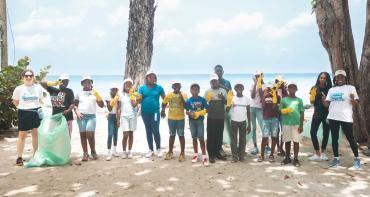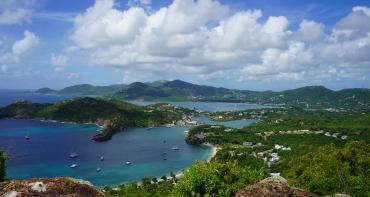The Commonwealth Blue Charter is highlighting case studies from the Commonwealth and beyond, as part of a series to spotlight best practice successes and experiences.

Share your own case study with us
Summary
Laughing Bird Caye National Park (LBCNP) was declared in 1994 and is one of seven protected areas making up the Belize Barrier Reef Reserve System, a World Heritage Site. While the land area is just 1.4 acres, the marine component of the park is 4,095 hectares. This protected area is one of the best examples of the unique type of atoll formation in the Caribbean.
LBCNP provides significant social and economic benefits to the local society. It is an important tourism resource, with over 10,000 visitors per year, given its proximity to Placencia Village just 11 miles away, and it provides sheltered snorkeling sites. In 2017, the Natural Capital Project at Stanford University valued LBCNP at almost US$5million/year (Nawaz et al., 2017). Because the site has no fishing allowed, it harbours good populations of conch, lobster and finfish, which then spill into local fishing areas.
Fragments of Hope (FOH) is a non-profit communitybased organisation that was formally established in 2013; FOH focuses on the restoration of coral reef habitats and advocacy for sustainable management of associated habitats. LBCNP was the first restoration site in Belize (2006) by FOH and is considered by most experts the best example of reef restoration in the Caribbean.
This case study is presented as it is an example of responsible restoration that has persisted. There are significant long-term conservation and economic benefits of successful coral reef restoration – for example tourism and fisheries are key industries in Belize that rely on the health of the reef. Restoration is, however, still a new and evolving strategy for retaining coral reefs into the future and so it is important to share and draw from experience.

The issue
Tourism and fisheries are key industries in Belize that rely on the health of the reef. In Belize, the shallow reefs have been valued at more than US$9 million/year in preventative storm damage alone. Over the past couple of decades, there have been significant declines in coral cover in Belize, as is the case for the whole Caribbean region – especially for the dominant and structurally important Acropora palmata or Elkhorn coral. Acroporids are keystone or foundation species in the Caribbean, branching and fast-growing, and therefore provide habitat and shelter for hundreds of other marine species, including the commercially important Spiny lobster. They thrive in shallow water, and it is the top metre of living reef that provides the most shoreline protection. This species has been affected by hurricanes, bleaching and white band disease. Because of these declines, all Caribbean acroporids (two species, one hybrid) were listed as Endangered Species in the USA in 2006 and as Critically Endangered on the International Union for Conservation of Nature Red List in 2008.
In 2001, Laughing Bird Caye National Park (LBCNP) was affected directly by Hurricane Iris, a category 4 hurricane, which caused massive damage to the fringing reefs in southern Belize, reducing coral cover to less than 6 per cent.
The response
The response to the decline of coral cover was active restoration through the transplantation of corals (initially acroporid corals) within LBCNP. Fragmentation is a natural form of asexual reproduction for acroporid corals and a form of natural adaptation to the high-energy environments in which they live.
Mapping of existing acroporids has been conducted in the warmest months of the year to identify naturally thermally tolerant corals. Genetic analyses are outsourced to ensure genetic diversity since the corals can sexually reproduce, and many different individuals of each species are needed to ensure self-reproducing/ sustaining restored populations. Long-term monitoring includes tracking these different individuals over time for growth and survival rates, longevity, bleaching and disease responses and evidence of sexual reproduction (spawning). Since the acroporids can reproduce via fragmentation, Fragments of Hope (FOH) began using photomosaics in 2014 to document coral cover changes on 100–200 m2 plots within LBCNP.
The restoration efforts undertaken by FOH engaged the local community, including the local fishers and tourism operators as well as staff from the Belize Fisheries Department.
Partnerships and support
There are significant long-term conservation and economic benefits of successful coral reef restoration. While the FOH team implements all the active reef restoration, the Belize Fisheries Department and the Southern Environmental Association are close partners.
The work has had several funders over the years (2006-present), primarily through short-term grants written and implemented by FOH:
- World Wildlife Fund (2009-present);
- The Global Environment Facility Small Grants Programme (GEF SGP) (2015-2019);
- Carib-Save (2015);
- The Inter-American Development Bank (IADB) (2014-2016);
- The Mesoamerican Reef Fund (the MAR Fund) (2018-2019);
- The Caribbean Community Climate Change Center (2011);
- The World Bank (2010);
- The Protected Areas Conservation Trust (2006- 2007);
- Private sector donations (2016-present).

FOH partners with a local licensed tour operator, Placencia Ecology Tours, and with local fishers to provide tours of local coral and mangrove ecosystems. All net profits go back into the restoration activities and contribute to the sustainability of these efforts.
Results, accomplishments and outcomes
A total of 82,879 nursery grown corals have been outplanted to LBCNP.
- Annual coral cover increases of 10–20 per cent, after initial outplanting and without adding more corals, have been documented at LBCNP, where over 1 hectare of shallow degraded reef has been replenished and persisted.
- Multiple genotypes of each species from these nursery-grown outplanted corals have sexually reproduced each year they were monitored (2014- 2017), with 89 per cent survival of the outplanted individuals after 13 years.
- The approach has been endorsed by the Belize Fisheries Department.
- A manual and three-day training curriculum have been developed targeting coastal community members and actors with interests in the reef. This helps transfer the knowledge for restoration of degraded reef areas within protected areas.
- There are now 23 in-situ coral nurseries throughout Belize.
- Exchanges, study visits and workshops have been conducted to share experience across the Caribbean, including in Colombia and St Barth’s: In 2016, IADB funded FOH and a coral restoration workshop in partnership with the University of the West Indies in Discovery Bay Jamaica. In 2018, there was a Belize/Mexico exchange facilitated by the MAR Fund and a Belize/ Jamaica exchange funded by GEF SGP.
- In 2016, FOH received international recognition for its work to demonstrate effective Caribbean acroporid population enhancement from the International Coral Reef Symposium, and in 2017 the Lighthouse Activity Award from the UN Secretariat for Climate Change.
- In 2018, FOH won a Women as Agents of Change Award from GEF SGP.
- In 2018 and 2019, FOH was invited to speak at UN Headquarters on the Commission on the Status of Women (CSW 62) and Solutions for Implementing Gender-Responsive Climate Action.

Challenges
Consistent, long-term funding is always a challenge and, even when sourced, the amount of administrative work (financial and technical) can be time-consuming. Climate change itself continues unabated with the lack of global political initiative to reduce emissions. Challenges include unpredictable weather patterns for fieldwork; increasing severity and frequency of storm events; increasing sea temperatures leading to ever-increasing severity of coral bleaching and disease events; and illegal fishing practices that can cause imbalanced food webs important for keeping coral predators (snails, fire worms) in check. Finally, the methods needed to accurately quantify restoration results (e.g. diver-based photo mosaics, drone mapping for larger areas) are more costly than the restoration work itself, and the processing technology must be outsourced (lack of capacity in country).
Key lessons learnt
What was novel was the ability to engage all the different partners that were needed to enable success, so that everyone was able to move towards a common vision.
- Involvement of local community and ownership of the restoration work has been very important for success and sustainability.
- Use of the same practitioners to undertake the restoration work had a positive impact in terms of building expertise.
- Other success factors identified include a low human population density, the protection of grazing species since 2009, the establishment of no-take zones and only undertaking out-planting outside of hurricane (and bleaching) season, between December and May.
Lead contact
Beverly Wade, Fisheries Administrator, Fisheries Department, Belize Vivian Ramnarace, Fisheries Department, Belize Lisa Carne, Fragments of Hope
Sources
Carne, L. (2011) ‘Reef Restoration at Laughing Bird Cay National Park, Belize’. Mesoamericana 15(3): 21-30. Nawaz, S., Bood, N. and Shal, V. (2017) Natural Heritage, Natural Wealth: Highlighting the Economic Benefits of the Belize Barrier Reef Reserve System World Heritage Site. WWF Technical Report. http://fragmentsofhope.org/
Download this case study (PDF)
View all Case Studies
Media contact
- Josephine Latu-Sanft Senior Communications Officer, Communications Division, Commonwealth Secretariat
- +44 20 7747 6476 | E-mail



